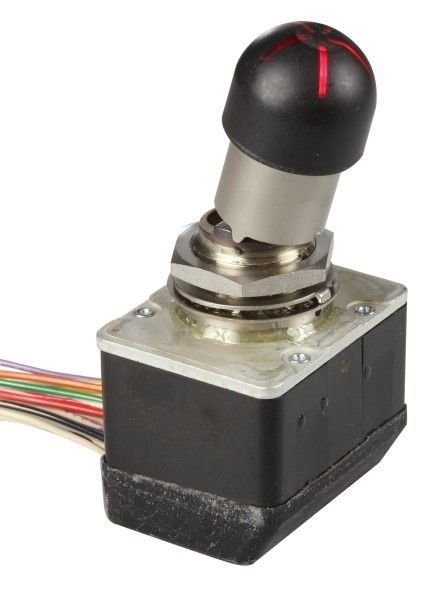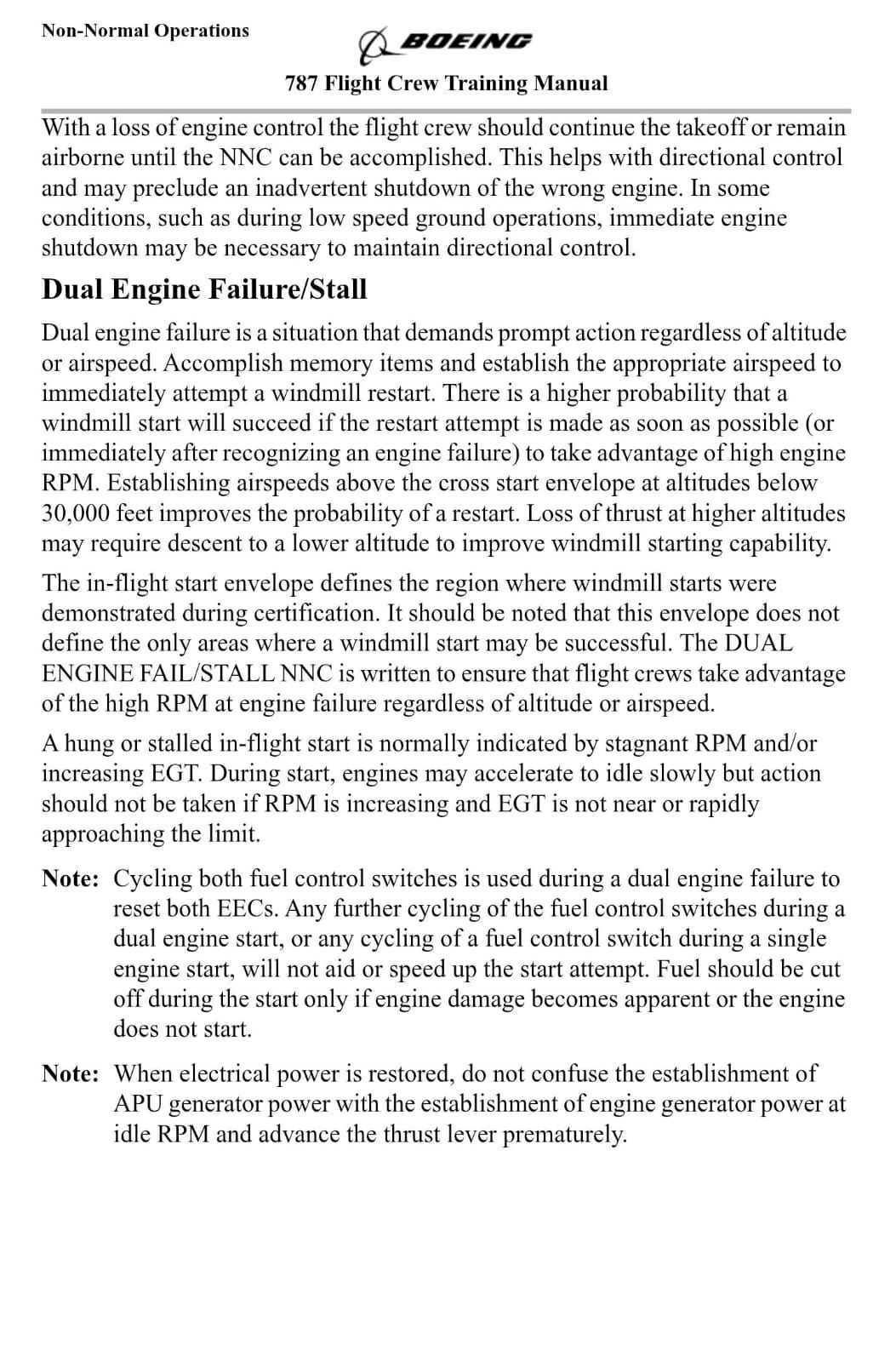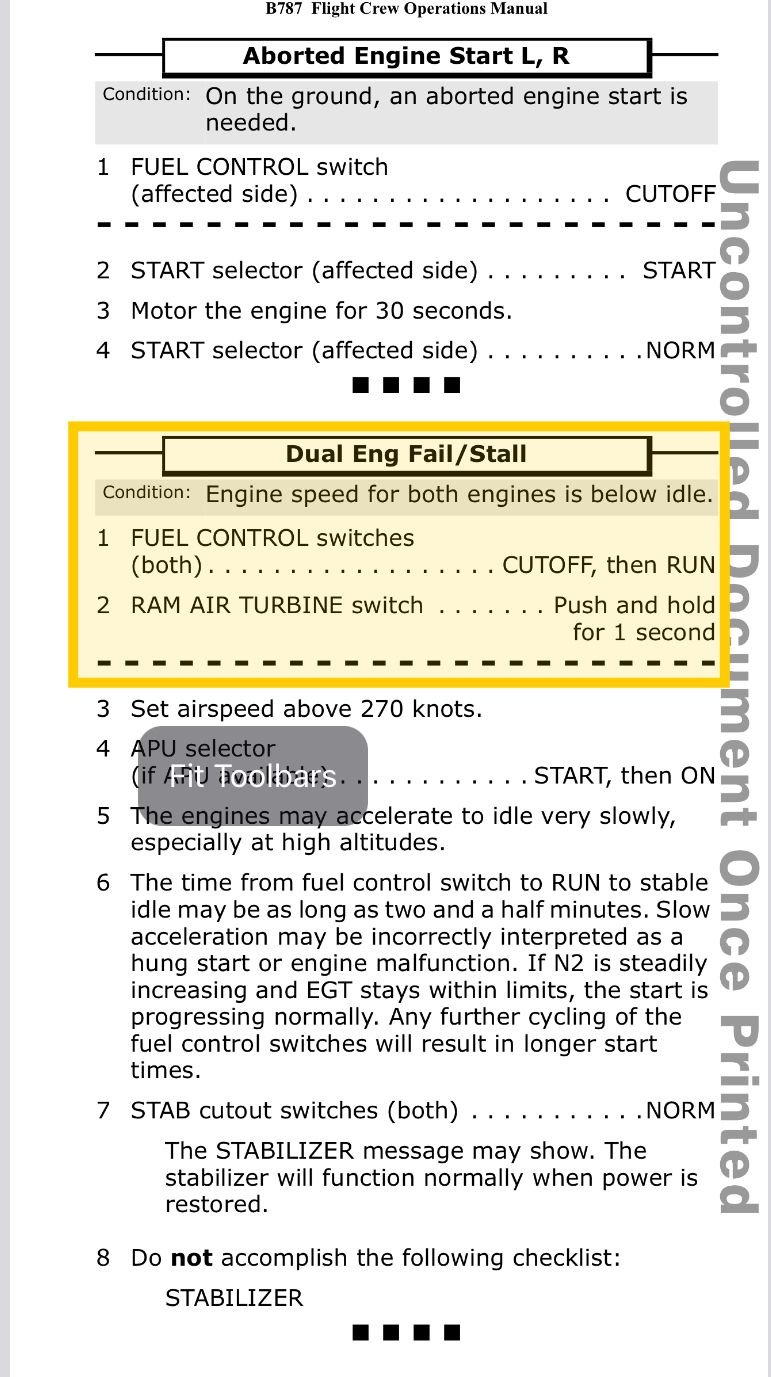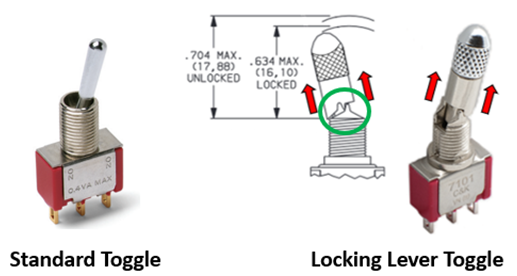July 09, 2025, 18:55:00 GMT
permalink Post: 11918554
I guess I\x92m hoping that there is (and trying to find) a logical explanation to this accident that we can all learn from and make sure it never happens again. There aren\x92t that many things that scare me in my job. Some of the alternatives I find terrifying for the industry, the manufacturer, the operators and the travelling public.
PPRUNE could make a rule that all accident threads are locked until the final report is published when it can be discussed (I\x92m sure the mods have been tempted at times)! I suspect the website wouldn\x92t get many hits if it did\x85..
Subjects
Fuel (All)
Fuel Cutoff Switches
Thread Moderation
Links are to this post in the relevant subject page so that this post can be seen in context.
The thread is closed so there are no user likes are available and no reply is possible.
July 09, 2025, 19:06:00 GMT
permalink Post: 11918557
There are many types where the shutoff position is a fully aft thrust lever, past a lift-up gate. Apparently this has caused a few human-factors issues because other types use the exact same mechanism for setting reverse thrust.
Subjects
Fuel (All)
Fuel Cutoff Switches
Links are to this post in the relevant subject page so that this post can be seen in context.
The thread is closed so there are no user likes are available and no reply is possible.
July 09, 2025, 19:20:00 GMT
permalink Post: 11918562
switches rapidly without following any procedure, in order to set the sim up for a single engine landing etc. When I was then line flying next I had to guard against doing the same thing in the real aircraft.
However, it can also bite us. The Delta dual engine shutdown during takeoff from LA (referenced way back when in the 1st accident thread) was caused by muscle memory - the pilot reached down to set the EEC switches (located near the fuel On-Off switches) but muscle memory caused him to do something else - set both fuel switches to OFF. Fortunately, he quickly recognized his error, placing the switches back to RUN and the engines recovered in time to prevent a water landing (barely).
It is conceivable that a pilot - reaching down to the center console to adjust something unrelated - could have muscle memory cause him to turn the fuel off to both engines. While all new engines are tested for "Quick Windmill Relight" - i.e. the fuel switch is set to CUTOFF with the engine at high power - and the engine must recover and produce thrust withing a specified time (memory says 60 or 90 seconds) - it takes a finite amount of time for the engines to recover (spool down after a power cut at high power is incredibly fast - plus moving the switch to CUTOFF causes a FADEC reset, which means it won't do anything for ~ 1 second). Doing that at a couple hundred feet and the chance that an engine will recover and start producing thrust before ground impact is pretty much zero
Subjects
Dual Engine Failure
Engine Failure (All)
Engine Shutdown
FADEC
Fuel (All)
Fuel Cutoff Switches
Muscle Memory
Quick Windmill Relight
RUN/CUTOFF
Relight
Switch Guards
Links are to this post in the relevant subject page so that this post can be seen in context.
The thread is closed so there are no user likes are available and no reply is possible.
July 09, 2025, 19:40:00 GMT
permalink Post: 11918572
And I would say the cut off switches do make a fairly unique click when being moved - I can hear it in my head as I write this!
Subjects
CVR
FDR
Fuel (All)
Fuel Cutoff Switches
Links are to this post in the relevant subject page so that this post can be seen in context.
The thread is closed so there are no user likes are available and no reply is possible.
July 09, 2025, 20:05:00 GMT
permalink Post: 11918581
Edit: And here it is:

Subjects
Fuel (All)
Fuel Cutoff
Fuel Cutoff Switches
Honeywell
Links are to this post in the relevant subject page so that this post can be seen in context.
The thread is closed so there are no user likes are available and no reply is possible.
July 09, 2025, 20:23:00 GMT
permalink Post: 11918592
However, it can also bite us. The Delta dual engine shutdown during takeoff from LA (referenced way back when in the 1st accident thread) was caused by muscle memory - the pilot reached down to set the EEC switches (located near the fuel On-Off switches) but muscle memory caused him to do something else - set both fuel switches to OFF. Fortunately, he quickly recognized his error, placing the switches back to RUN and the engines recovered in time to prevent a water landing (barely).
It is conceivable that a pilot - reaching down to the center console to adjust something unrelated - could have muscle memory cause him to turn the fuel off to both engines. While all new engines are tested for "Quick Windmill Relight" - i.e. the fuel switch is set to CUTOFF with the engine at high power - and the engine must recover and produce thrust withing a specified time (memory says 60 or 90 seconds) - it takes a finite amount of time for the engines to recover (spool down after a power cut at high power is incredibly fast - plus moving the switch to CUTOFF causes a FADEC reset, which means it won't do anything for ~ 1 second). Doing that at a couple hundred feet and the chance that an engine will recover and start producing thrust before ground impact is pretty much zero
It's ironic that cognitive science arguably started with 'The Cambridge Cockpit'; an attempt to make sense of, and mitigate, pilots doing this sort of thing when tired, stressed and so on. This kick started an ergonomics revolution which appears to have come full circle. Now we have cognitive science offering Bayesian accounts of neural function that might explain how innocent but unfortunate priming of 'muscle memory' when practicing for emergencies could, almost predictably, lead to this sort of complex, protection overriding, error.
As non consciously executing a complex, well practiced, but unintended, action is a fairly common experience in less critical situations, I'm surprised that there isn't already a more effective ergonomic fix than the safety switches fitted.
Last edited by Subsy; 9th July 2025 at 22:58 .
Subjects
Dual Engine Failure
Engine Failure (All)
Engine Shutdown
FADEC
Fuel (All)
Fuel Cutoff Switches
Muscle Memory
Quick Windmill Relight
RUN/CUTOFF
Relight
Links are to this post in the relevant subject page so that this post can be seen in context.
The thread is closed so there are no user likes are available and no reply is possible.
July 09, 2025, 22:34:00 GMT
permalink Post: 11918651
Edit: And here it is:
For those unfamiliar with cockpit controls in general, I\x92ll leave my \x93schematic\x94 image to show the principle of \x93lift-and-move\x94 the toggle vice just pushing the toggle in a desired direction.
Cheers,
PJ2
Last edited by PJ2; 9th July 2025 at 22:45 . Reason: for context
Subjects
Fuel (All)
Fuel Cutoff
Fuel Cutoff Switches
Honeywell
Links are to this post in the relevant subject page so that this post can be seen in context.
The thread is closed so there are no user likes are available and no reply is possible.
July 09, 2025, 23:25:00 GMT
permalink Post: 11918671
But this is starting to devolve into a hamster wheel again.
Last edited by Chernobyl; 10th July 2025 at 05:32 .
Subjects
Fuel (All)
Fuel Cutoff Switches
Preliminary Report
Relight
Links are to this post in the relevant subject page so that this post can be seen in context.
The thread is closed so there are no user likes are available and no reply is possible.
July 10, 2025, 00:20:00 GMT
permalink Post: 11918695
Attached is an image of a page from the Air India 787 Training Manual that discusses this procedure.
I am submitting this without comment or opinion.

Subjects
Dual Engine Failure
Engine Failure (All)
Fuel (All)
Fuel Cutoff Switches
RUN/CUTOFF
Relight
V1
Links are to this post in the relevant subject page so that this post can be seen in context.
The thread is closed so there are no user likes are available and no reply is possible.
July 10, 2025, 01:08:00 GMT
permalink Post: 11918713
Deliberately cycling the Engine Cutoff switches just after rotate, in response to a dual power loss is inconceivable. You are way too low and slow for it to have any effect and your attention is better devoted to aiming for the flattest area ahead to crash into. Commencing the Dual Eng Fail/Stall checklist memory items is conditional upon both engines being at sub-idle and the aircraft being within the in-flight relight envelope. Neither of those conditions existed.
Subjects
Fuel (All)
Fuel Cutoff Switches
Memory Items
Relight
Links are to this post in the relevant subject page so that this post can be seen in context.
The thread is closed so there are no user likes are available and no reply is possible.
July 10, 2025, 01:21:00 GMT
permalink Post: 11918716

Obviously, because it's going to require quick action to catch high RPM. And maybe that's what they tried.
Subjects
Dual Engine Failure
Engine Failure (All)
Fuel (All)
Fuel Cutoff Switches
Relight
Links are to this post in the relevant subject page so that this post can be seen in context.
The thread is closed so there are no user likes are available and no reply is possible.
July 10, 2025, 01:57:00 GMT
permalink Post: 11918722
Subjects
FDR
Fuel (All)
Fuel Cutoff Switches
Links are to this post in the relevant subject page so that this post can be seen in context.
The thread is closed so there are no user likes are available and no reply is possible.
July 10, 2025, 02:30:00 GMT
permalink Post: 11918727
Subjects
Fuel (All)
Fuel Cutoff Switches
RAT (All)
Relight
Links are to this post in the relevant subject page so that this post can be seen in context.
The thread is closed so there are no user likes are available and no reply is possible.
July 10, 2025, 02:41:00 GMT
permalink Post: 11918730
* (Or to be fair, these guys, this cockpit team were...)
Last edited by MaybeItIs; 10th July 2025 at 02:55 . Reason: grammar (still bad, never mind), a bit better 2nd time
Subjects
Fuel (All)
Fuel Cutoff Switches
RAT (All)
Links are to this post in the relevant subject page so that this post can be seen in context.
The thread is closed so there are no user likes are available and no reply is possible.
July 10, 2025, 09:26:00 GMT
permalink Post: 11918827
I'm not saying that this happened to this crew but it certainly could happen to someone. People do weird !!!! under high stress. There is an initial "oh !!!!, what's going on" then the training kicks in. Often at super fast rate and the challenge becomes slowing it all down.
The bloody master warning on the Airbus for smoke in the forward Lav used to get me everytime. Was always at night over the ocean too.

Subjects
Dual Engine Failure
Engine Failure (All)
Fuel (All)
Fuel Cutoff
Fuel Cutoff Switches
Memory Items
Links are to this post in the relevant subject page so that this post can be seen in context.
The thread is closed so there are no user likes are available and no reply is possible.
July 10, 2025, 09:59:00 GMT
permalink Post: 11918849
I don't see it written in the 787 FCOM but I have always been told that the action of resetting the Engine Cutoff switches in the event of a dual engine failure, is merely backing up what the FADECs have already done. If there is an 'engine event' the FADECs will manage ignition and fuel-flow to restore the thrust that was demanded before the event. If that management has failed then the manual resetting may be more successful. (The same holds true for the RAT, manual selection is merely backing up the auto-deployment).
Any airline pilot will tell you that executing an in-flight relight on a big engine, no matter if it is by electric start, windmilling RPM or cross-bleed assisted, can take between 1 and 3 minutes to restore power. This aircraft was airborne for less that 30 seconds. No pilot in his right mind would prioritise an in-flight relight procedure, in a situation where they had neither the time, the height nor the speed for it to succeed. I have no doubt the crew focussed entirely on pointing the aircraft at the clearest area they could see, to mitigate what would inevitably follow.
Subjects
Dual Engine Failure
Engine Failure (All)
FCOM
Fuel (All)
Fuel Cutoff Switches
RAT (All)
Relight
Links are to this post in the relevant subject page so that this post can be seen in context.
The thread is closed so there are no user likes are available and no reply is possible.
July 10, 2025, 10:36:00 GMT
permalink Post: 11918879
D Bru : if that were actually the scenario, would they not instead be focusing on why "for some extraordinary reason [they were] confronted with both engines out on lift off", rather than having "narrowed its focus to the movement of the plane's fuel control switches", which would just be a side effect not a root cause?
But this is starting to devolve into a hamster wheel again.
Anyway, the other thread is open at the moment, maybe this should be moved there.
Subjects
Fuel (All)
Fuel Cutoff Switches
Links are to this post in the relevant subject page so that this post can be seen in context.
The thread is closed so there are no user likes are available and no reply is possible.
July 10, 2025, 10:59:00 GMT
permalink Post: 11918893
Condition: Engine speed for both engines is below idle
Fuel Control Switches (both) \x85 CUTOFF then RUN
RAM AIR TURBINE switch \x85 Push and hold for1 second
Subjects
Fuel (All)
Fuel Cutoff Switches
Memory Items
RUN/CUTOFF
Links are to this post in the relevant subject page so that this post can be seen in context.
The thread is closed so there are no user likes are available and no reply is possible.
July 10, 2025, 12:12:00 GMT
permalink Post: 11918942
Subjects
Fuel (All)
Fuel Cutoff Switches
Links are to this post in the relevant subject page so that this post can be seen in context.
The thread is closed so there are no user likes are available and no reply is possible.
July 10, 2025, 12:14:00 GMT
permalink Post: 11918946
Condition: Engine speed for both engines is below idle
Fuel Control Switches (both) \x85 CUTOFF then RUN
RAM AIR TURBINE switch \x85 Push and hold for1 second

Subjects
Fuel (All)
Fuel Cutoff Switches
Memory Items
RUN/CUTOFF
Links are to this post in the relevant subject page so that this post can be seen in context.
The thread is closed so there are no user likes are available and no reply is possible.
